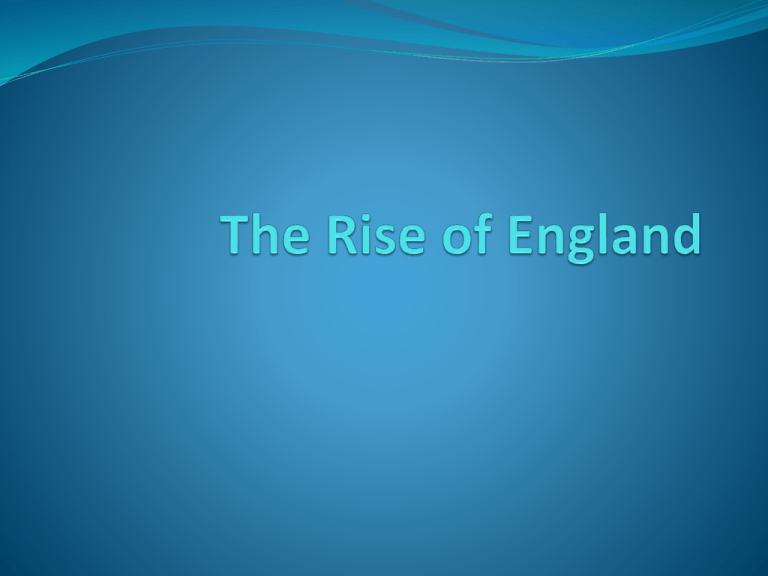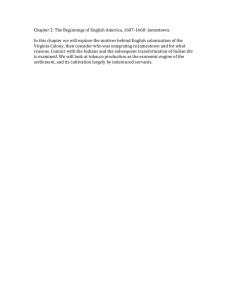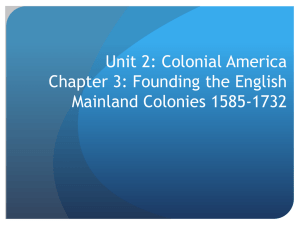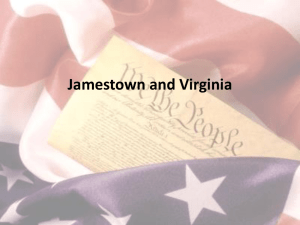The Rise of England
advertisement

Protestant Reformation Led by Martin Luther Excommunicated by Catholic Church Heads of state determined “state” religion Lutherans Germany, Scandinavia Catholics Spain, Portugal, France, Italy, Ireland, Germany, Poland Calvinists Scotland, the Netherlands, Germany Anglicans England Protestant Reformation Protestant Reformation Calvinism God is absolute He directs mankind to His liking People are predestined Discipline was demanded Luxury and merriment prohibited Protestant Reformation Anglicans (Church of England) Henry VIII broke with Church over divorce King = head of state and church What options did you have? England’s Voyages of Discovery John Cabot (Italian) paid by England to duplicate Columbus Sailed further north (1498-99( Discovered eastern Canada and New England Issues in England GOOD BAD Better health Price inflation Gentry increased wealth Nobility lost money (land (short term land leases adding in inflation) Yeoman increased wealth (price increase of crops) Property owners gained power in Parliament (House of Commons) leases fixed) Nobility lost political influence (House of Lords) Peasants lost land to landlords and merchants for sheep production (enclosure) Mercantilism Defined: State supported manufacturing and trade as a way to increase national power and wealth In practice: Merchants bought wool from landowners, landless peasants (cotters) spun the wool into cloth, merchants sold cloth in England and foreign countries Crown provided charters for merchants Merchants allowed to fix wages (keep costs down) Import taxes made crown wealthy Domestic investment made merchants wealthy By mid to late 1500’s England an economic power Colonization Colonies needed: Funding ships and supplies trained soldiers Willing settlers Few wanted to colonize (English economy booming) The Crown offered ‘charters’ to private investors The most likely groups religious dissenters – the Church of England was not sufficiently “reformed” yeomen looking for new lands to farm Peasants looking for economic opportunity Colonization Three types of Colonies Royal (Provincial) Granted by Crown Governed by commissions (working for King) Governor had power Virginia, New Hampshire, New York, North Carolina, South Carolina, Georgia Colonization Three types of Colonies Charter Political in nature Grantees controlled the land Legislative government Massachusetts, Rhode Island, Connecticut Colonization Three types of Colonies Proprietary Granted by the Crown Proprietors of land chose governor Proprietors had general government control (subject to the king) Pennsylvania and Delaware (William Penn), New Jersey (Sir George Carteret and Lord Berkley), Maryland (George Calvert, 1st Lord Baltimore) First Colonies Sir Walter Raleigh & Roanoke 1585: fails scarce food hostile relations with natives returned to England 1587: 110 people Return 3 years later Everyone gone . . . Virginia Jamestown Corporate colony London Company – 56 firms and 659 individuals invested Granted by King James I North Carolina to New York Named Virginia after Queen Elizabeth I Jamestown settled 1607 Jamestown Fort & Settlement Map Growth (near death) of Jamestown 1607 – 104 men Unprepared “gentlemen” colonists Settlers wasted time (gold) Expected native support 38 survived winter Gov. John Smith saved colony Difficult early years . . . By 1611 1,200 settlers arrived Half died, most due to famine Relations between Indians & settlers worsened English stole from Indians 1610-1614 -- First Anglo- Powhatan War Gov. Thomas West (Lord De La Warr) had orders to make war. Raided villages, burned houses, took supplies, burned cornfields. John Rolfe helped save colony John Rolfe Introduced tobacco the leading export to England – a “cash crop” Poor white workers sent to cultivate it 1619, 20 Africans bought from Dutch – first slaves 1614 Rolfe married Pocahontas Jamestown Housing Jamestown Settlement Jamestown Chapel Culture Clash 1614 to 1622 = peace Indian Uprising of 1622 Whites taking Indian lands 1/3 whites killed (including Rolfe) Whites destroyed Indian food supply End of coexistence 1644-1646 Second Anglo-Powhatan War Last effort of natives Indians defeated again Peace Treaty of 1646 Removed Powhatans from original land Separation of Indians and English Battle For Land Powhatan Confederacy Jamestown Settlement High Mortality Rates “Starving Time”: 1607: 104 colonists By spring, 1608: 38 survived 1609: 300 more immigrants By spring, 1610: 60 survived 1610 – 1624: 10,000 immigrants 1624 population: 1,200 Adult life expectancy: 40 years Death of children before age 5: 80% Government The House of Burgesses Established 1619 Could make laws and levy taxes Still subject to the governor and company, (not King) Made up of landowning men 1624 King James dissolved London Co. and made Virginia a royal colony James opposed to tobacco Distrusted House of Burgess as independent body This meant . . . House of Burgesses had to get laws approved by King’s Council Church of England became official religion in Virginia What was the focus of the Virginia Colony? Maryland The Settlement of Maryland royal charter granted to George Calvert, Lord Baltimore (1632) A proprietary colony (1634) Tobacco main crop Absentee proprietor (feudal relationship) Appointed brother Leonard governor A Haven for Catholics Catholic relatives received land Other colonists wanted land Modest farms around Chesapeake Catholic land barons and Protestant small farmers Gov. Calvert tried to prevent representative democracy 1638 Lord Baltimore allowed for legislative body A Haven for Catholics Baltimore allowed freedom of worship Protestants felt threatened by Catholics Led to uprising Toleration Act of 1649 Supported by Catholics Guaranteed toleration to all CHRISTIANS Decreed death to those who denied the divinity of Jesus (Jews, atheists, etc.) Political Outcome By 1650 a bicameral legislature in place Upper House Appointed Who would this be? Lower House Elected by freemen Who would this be? What was the focus of the Maryland Colony? Tobacco and Rebellion Tobacco Trade 1618 — Virginia produces 20,000 pounds of tobacco. 1622 — Despite losing nearly one-third of its colonists, Virginia produces 60,000 pounds of tobacco. 1627 — Virginia produces 500,000 pounds of tobacco. 1629 — Virginia produces 1,500,000 pounds of tobacco Tobacco Allowed Chesapeake region to flourish Needed labor source Mosquito infested Many men died from malaria Left women in unusual position of wealth Indentured Servitude Poor left England seeking fortune Between 1640-1700 80,000 came to Virginia 20,000 came to Maryland Indentured Servitude Indenture Contract: 5-7 years (up to age 21 for youth) Promised “freedom dues” [land, money] Forbidden to marry Fed, clothed, sheltered Headright System: Each Virginian got 50 acres for each person whose passage they paid More indentured servants = more land Indentured Servitude Bad for Servants: Masters had total control Could beat servants Could extend contracts Sometimes sexually abused women Only about 25% benefitted by end of contract Good for Masters: High profit margin for tobacco Could gain more land Due to lack of women in colonies, men sometimes married female servant Frustrated Freemen By 1660 economy dropped Tobacco no longer profitable Small group of large landowners survived King raised taxes Many smaller farmers became landless Farmers grew more (supply 1670 Virginia Assembly and demand) Farmers lost land Indentured servants had no hope of buying land disenfranchised most landless men Social impact? Navigation Acts 1651 – Act of Trade and Navigation Only English ships allowed in American ports American merchants only allowed to trade with English Lost trade with more profitable countries Began drop in colonial economy Nathaniel Bacon’s Rebellion: 1676 Governor William Berkeley Governor – 1642-1652 Ended Indian Wars in 1644 (guaranteed Indian lands) Governor again in 1660 Corrupt! Gave land and offices to friends and relatives Nathaniel Bacon’s Rebellion: 1676 Poorer whites were forced farther west (Indian land) Berkeley monopolized fur trade with Indians Berkley refused to retaliate for Indian attacks on frontier settlements. Led to war in 1675 – Susquehannock chiefs murdered Berkeley raised taxes to pay for western forts Nathaniel Bacon’s Rebellion: 1676 Nathaniel Bacon Wealthy English settler in western Virginia Attacked Indians (against Berkeley) Supporters gained power in House of Burgesses Led 1,000 Virginians in a rebellion against Berkeley Berkeley driven from Jamestown Nathaniel Bacon’s Rebellion: 1676 Bacon Manifesto Death or removal of all Indians End of rule of wealthy “parasites” What type of war is Bacon waging? Bacon’s men burned capital Rebels went on a rampage Bacon suddenly died (dysentery) Berkeley brutally crushed the rebellion; hanged 20 rebels Results of Bacon’s Rebellion Exposed internal clashes Inland frontiersmen/ landless former servants vs. gentry on coastal plantations. rural vs. urban Led the upper class planters (elite) to Share power Enslave Africans (less likely to rebel) Why would the planter class do this?



